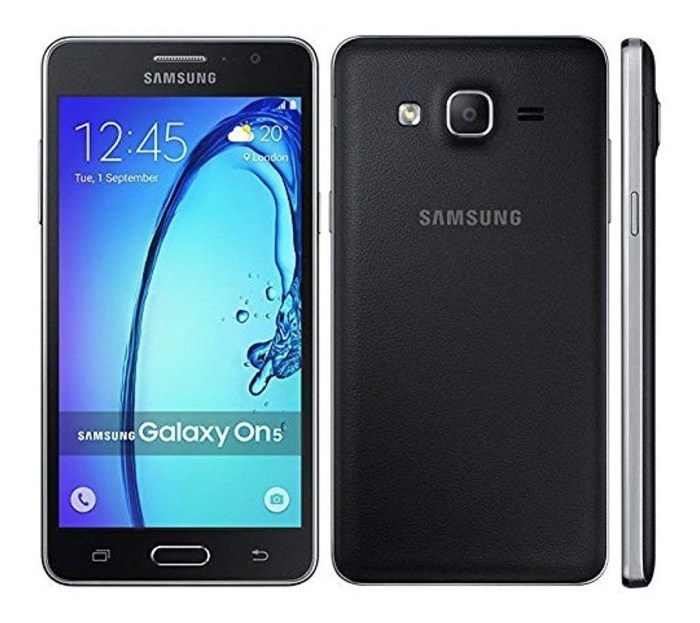Samsung Galaxy On5 Specification Details
Samsung Galaxy On5: A Retrospective Look

Source: chiptrolls.com
Samsung galaxy on5 specification – The Samsung Galaxy On5, launched in 2015, represented Samsung’s attempt to capture a significant share of the budget smartphone market. Targeting young adults and first-time smartphone users, it aimed to provide a balance of functionality and affordability. This article delves into the specifications, features, and overall impact of this device.
Samsung Galaxy On5 Overview

Source: chiptrolls.com
The Galaxy On5 was positioned as an entry-level smartphone offering a compelling blend of features at a competitive price point. Its key selling points at launch included a decent camera, expandable storage, and a familiar Samsung user experience. It launched in various regions throughout 2015, with initial pricing varying slightly depending on the market but generally falling within the $150-$200 USD range.
The Samsung Galaxy On5 specification, while a solid budget offering in its time, pales in comparison to newer models. For a more contemporary example of Samsung’s capabilities, check out the detailed specifications for the Samsung Galaxy A32 5G, available here: samsung galaxy a32 5g full specification. Comparing the two highlights the significant advancements in processing power, camera technology, and overall performance found in the newer A-series devices, showcasing how much the Samsung Galaxy On5’s specs have been surpassed.
| Processor | RAM | Storage | Camera |
|---|---|---|---|
| Qualcomm Snapdragon 410 or Exynos 3475 (region dependent) | 1.5 GB | 8 GB (expandable via microSD) | 8 MP rear, 5 MP front |
Direct competitors at launch included budget offerings from other manufacturers like Xiaomi, Lenovo, and Motorola, each vying for the same price-sensitive consumer base.
Hardware Specifications

Source: celularess.com
The Galaxy On5’s hardware specifications reflected its budget positioning. While not cutting-edge, they provided adequate performance for everyday tasks.
The processor, either a Qualcomm Snapdragon 410 or Exynos 3475 (depending on the region), offered a quad-core architecture with a clock speed typically around 1.3 GHz. The 1.5 GB of RAM, while limited by today’s standards, allowed for basic multitasking and app usage. Internal storage was 8 GB, expandable via microSD card, addressing the common need for additional space for media and applications.
The display featured a 5-inch screen with a resolution of 720 x 1280 pixels, utilizing PLS LCD technology.
| Battery Capacity | Typical Usage Time |
|---|---|
| 2600 mAh | A full day of moderate use, with heavier use potentially requiring a mid-day charge. |
Camera Features
The Galaxy On5 featured an 8-megapixel rear camera with autofocus and LED flash, and a 5-megapixel front-facing camera. Image quality was generally acceptable in well-lit conditions, producing reasonably sharp and detailed photos. In low-light situations, image noise became more noticeable, and detail suffered. Compared to contemporaries in the same price bracket, the camera performance was average, neither particularly outstanding nor significantly lacking.
Software and User Interface
The Galaxy On5 shipped with Android 5.1 Lollipop and Samsung’s TouchWiz UI. This interface offered a level of customization, allowing users to personalize their home screens, widgets, and other aspects of the user experience. Several Samsung-branded applications were pre-installed, including their email client, gallery, and other utilities.
- Android 6.0.1 Marshmallow
- No further major OS updates were released.
Connectivity and Sensors
Connectivity options included Wi-Fi, Bluetooth, GPS, and 4G LTE mobile data, providing a comprehensive suite for various communication and location-based services. The built-in sensors included an accelerometer and proximity sensor, enhancing the user experience and enabling features such as screen rotation and automatic call muting during calls.
The combination of these sensors and connectivity options enabled standard smartphone functionalities such as location-based services, seamless internet connectivity, and smooth app performance.
Legacy and Impact, Samsung galaxy on5 specification
The Samsung Galaxy On5 received mixed reviews. While praised for its affordability and familiar Samsung interface, its performance limitations and average camera were frequent criticisms. Compared to modern budget smartphones, its specifications appear dated, with significantly less RAM and processing power. Within Samsung’s lineup, it served as a crucial entry-level offering, aiming to expand the brand’s reach to budget-conscious consumers.
- Strengths: Affordable price, expandable storage, familiar Samsung interface.
- Weaknesses: Limited RAM, average camera performance in low light, outdated processor by today’s standards.
FAQ Corner: Samsung Galaxy On5 Specification
Did the Samsung Galaxy On5 receive any significant security updates after its initial release?
While the exact duration and number of security updates vary depending on region and carrier, the Galaxy On5 did receive several security patches throughout its lifecycle, though likely not as extensive as flagship models.
How does the Galaxy On5’s battery life compare to similar phones from that era?
Battery life was generally considered average for its time, offering a full day of moderate use. However, heavy usage, particularly gaming or streaming, could significantly reduce battery life.
What was the general consumer sentiment towards the Samsung Galaxy On5?
Reviews were generally mixed. While praised for its affordability and ease of use, some criticized its processing power and camera quality compared to more expensive alternatives.





















